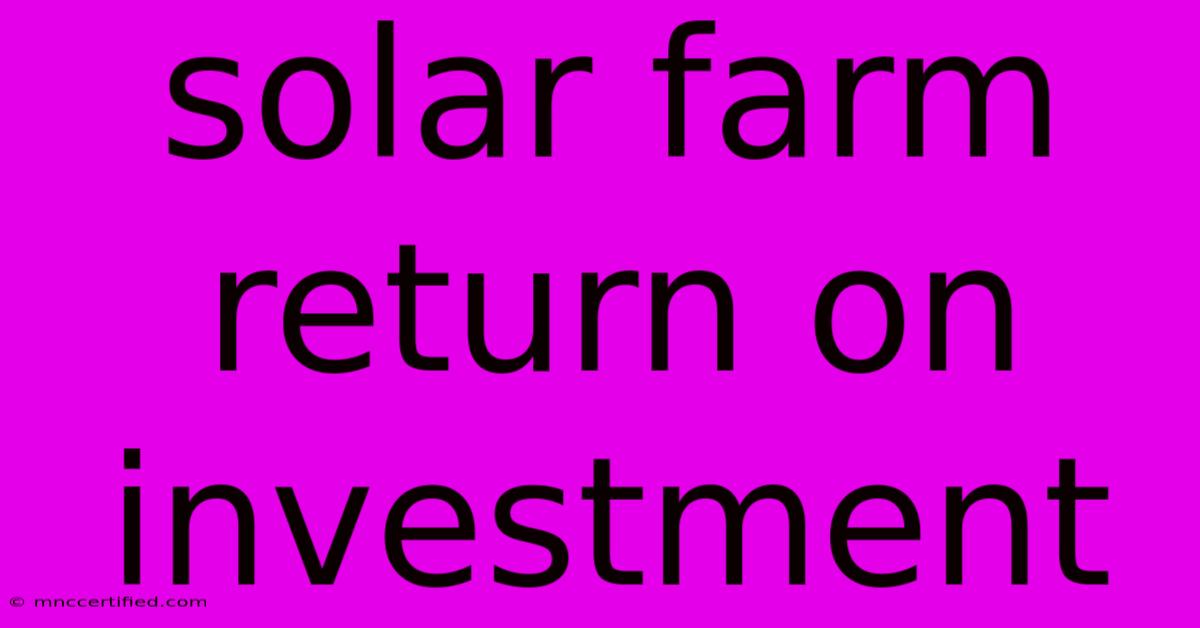Solar Farm Return On Investment

Table of Contents
Solar Farm Return on Investment: A Comprehensive Guide
Investing in a solar farm presents a compelling opportunity for substantial returns, but understanding the intricacies of its ROI is crucial for making informed decisions. This comprehensive guide delves into the key factors influencing the profitability of solar farm investments, helping you navigate the complexities and assess the potential returns.
Understanding the Components of Solar Farm ROI
Calculating the return on investment for a solar farm isn't a simple equation. It involves a multitude of factors, each playing a critical role in determining your ultimate profitability. Let's break down the key components:
1. Initial Investment Costs:
This encompasses all upfront expenses, including:
- Land acquisition: The cost of purchasing or leasing suitable land for your solar farm is a significant initial investment. Location plays a crucial role here, impacting both land costs and energy production potential.
- Solar panel costs: The price of solar panels fluctuates, depending on technology, efficiency, and market demand. Investing in higher-efficiency panels may offer long-term cost savings.
- Inverter costs: Inverters are essential for converting DC power from the panels into usable AC power. Selecting efficient inverters is vital for optimizing energy output.
- Balance of system (BOS) costs: This includes all other components, such as racking systems, wiring, transformers, and monitoring equipment. Careful planning and sourcing can help minimize these costs.
- Permitting and interconnection fees: Securing the necessary permits and connecting to the grid can involve significant expenses and time delays. Thorough due diligence is crucial.
- Construction costs: This involves labor costs for installation and other construction-related expenses.
2. Operational Expenses:
Ongoing costs associated with the solar farm's operation include:
- Maintenance: Regular maintenance, including cleaning panels and repairing equipment, is crucial for optimal performance and longevity.
- Insurance: Protecting your investment with appropriate insurance policies is essential.
- Property taxes: Depending on your location, you'll need to factor in property taxes on the land and equipment.
- Monitoring and management: Remote monitoring systems and potentially on-site management contribute to ongoing expenses.
3. Revenue Streams:
The revenue generated by your solar farm largely depends on several key factors:
- Energy production: The amount of energy your solar farm generates is influenced by factors like solar irradiance (sunlight intensity), panel efficiency, and system design. Careful site selection and system optimization are key.
- Power purchase agreements (PPAs): PPAs are contracts with utilities or corporations to sell the electricity generated by your solar farm. Negotiating favorable PPA terms is crucial for maximizing revenue.
- Renewable energy credits (RECs): Some regions offer RECs, which can generate additional income by selling credits associated with the renewable energy your farm produces.
- Tax credits and incentives: Government incentives and tax credits can significantly impact your overall ROI. Research available incentives in your area.
4. Calculating ROI:
Calculating the ROI involves comparing the total net revenue (revenue minus expenses) over the lifespan of the solar farm to the initial investment. Sophisticated financial modeling software can help you accurately forecast cash flows and assess the potential return.
Factors Influencing Solar Farm ROI
Several factors can significantly influence the profitability of your solar farm investment:
- Location: Areas with high solar irradiance will yield higher energy production and subsequently higher returns.
- Technology: Choosing efficient solar panels and inverters will improve energy output and lower operational costs.
- Financing: Securing favorable financing options can significantly impact your upfront investment and overall return.
- Market conditions: Fluctuations in electricity prices and the demand for renewable energy will affect your revenue.
- Policy and regulation: Government policies, regulations, and incentives play a major role in the profitability of solar farm investments.
Maximizing Your Solar Farm ROI
To maximize your return on investment, consider the following strategies:
- Conduct thorough due diligence: Analyze site suitability, energy production potential, and market conditions before investing.
- Optimize system design: Employ efficient technologies and design strategies to maximize energy output.
- Secure favorable financing: Explore different financing options to secure the best terms.
- Negotiate favorable PPAs: Secure advantageous power purchase agreements with utilities or corporations.
- Stay updated on industry trends and regulations: Continuously monitor changes in technology, market conditions, and government policies.
Conclusion: A Promising Investment with Careful Planning
Investing in a solar farm can be a lucrative endeavor, offering attractive long-term returns. However, understanding the complexities of ROI and implementing effective strategies is essential for success. By carefully considering the factors outlined in this guide and employing sound financial planning, you can significantly increase your chances of achieving a substantial return on your solar farm investment. Remember to consult with financial and legal professionals to ensure you make informed decisions tailored to your specific circumstances.

Thank you for visiting our website wich cover about Solar Farm Return On Investment. We hope the information provided has been useful to you. Feel free to contact us if you have any questions or need further assistance. See you next time and dont miss to bookmark.
Featured Posts
-
Revealed Ipswich Fans Argument
Nov 26, 2024
-
Lauren Laverne Cancer All Clear
Nov 26, 2024
-
Nile River Cruise Ancient Egypt
Nov 26, 2024
-
Sex Abuse Evidence Menendez Brothers Freedom
Nov 26, 2024
-
Does Insurance Cover Loaner Car
Nov 26, 2024